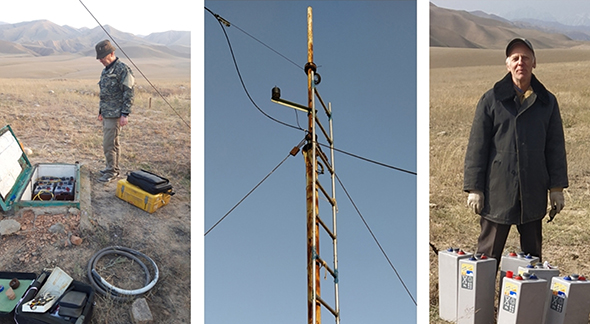RS RAS and IS NAS KR scientific collaboration
June 11, 2021
The cooperation between the RS RAS and the Institute of Seismology of the National Academy of Sciences of the Kyrgyz Republic (IS NAS KR) continues in the field of seismological research.
The employees of the Institute of Seismology carried out field seismological research in the Issyk-Kul region in accordance with two agreements from January 8th to May 21t, 2021. The Group of New Technologies Introduction has prepared and delivered three sets of RT130-01 seismic stations with STS-2 seismic sensors. The software and methodological documents for conducting research were also handed over. RT130-01 stations and STS-2 seismic sensors were purchased with financial assistance of CRDF (U.S. Civilian Research and Development Foundation) - American Civilian Research and Development Foundation.
Field works involves the installation of RT130-01 type seismic stations, complete with wide-range STS-2 seismic sensors in the studied area and continuous recording for a certain time of microseisms and vibrations from remote earthquakes and industrial explosions. The duration of observations depends on the level of seismic activity at the territory and is set in such a way as to register at least 10 seismic events with good recording quality. One recording point was taken as a reference. The rest of the items are mobile.
Problems arose during the data processing. The level of seismic interference is significantly higher than the level of microseisms during the station installation and the terminal usage, with the help of which the equipment is controlled and monitored. Microseisms are indistinguishable in comparison with these background disturbances. It is necessary to remove noisy beginning and the end in the data record and areas with the operator presence near the sensor for high-quality data processing.
The staffs of GNTI RS RAS also provide IS NAS KR with methodological assistance, operator training and consultations during field work, provision of seismic data processing programs.
The maintenance of the network of GPS stations continues. You can see below the workplace at the Osh’s station in the picture:

After 7 years of cooperation, our curator Sarah Doelger moved to another UNAVCO division. Jacob Sclar will temporarily perform her duties.
KNET и GPS geophysical nets operation
04th September 2020г.
The scheduled works at KNET and GPS nets objects were made by the Group of New Technologies Introduction (GNTI) after the COVID quarantine cancellation.
The top part of the KNET East Repeater mast was bended by strong wind. Fortunately the antennas were not damaged.

Two masts for antennas directed to the Chumysh Repeater, ULHL and KZA stations were installed to fix the problem. The solar panels were left on the old thick mast. The Institute for Seismology of the National Academy of science of Kyrgyzstan employee Tatjana Nikitenko assists to monitor the stations operation.

The leading engineer S.M. Konovalov prepared new GPS server to swap the old one in communication chamber. Trips to update the TALA and SUMK GPS stations are scheduled in autumn time.
The stations data download occurs in normal mode. Operators-colleagues perform the data transfer from 4 stations: KMTR (at Kumtor mining), KRTV (close to Kurchatov city in Kazakstan), SEL2 (close to Medeu skate ring), PODG (close to Podgornoe village 200 km away to East from Almaty). 4 stations data is downloading automatically through the phone and radio channels by GPS server. The GPS data quantity and quality are checked by special program and staff daily. 2 stations data (OSHK and KAZA) is download manually by NEI group staff.
Unfortunately it is impossible to reach the RS RAS objects in Kazakstan due to the quarantine. The important arrangements were performed by Chumysh Repeater guards.
14th October 2020.
The reliability increasing of the data download process was the purpose of visit to TALA (Talas city) GPS station on 22-24th September. The second purpose was to decrease the expenses for data download through the intertoll trunk. Modernization arrangements were made by the Group of New Technologies Introduction (GNTI) leading engineer Sergey Konovalov.
The intertoll trunk communication channel troubles appeared periodically before of the old phone radio extender. The line of sight between RS RAS and 21t Phone Station disturbs some times.
The GSM 900/1800МГц cellular modem TELEOFIS RX100-R2В was bought in Moscow. The modem firmware was update after interaction with supplier. Many program changes were made in the GPS server located in the communication room. The data transfer testing was made at RS RAS. O! cellular provider is used. The modem and external antenna were installed at GPS station. The data download process through cellular network starts by GPS server at first. The cellular data transfer is cheaper as intertoll trunk transfer. The intertoll trunk transfer start at second time if all the data was not download. The data residual downloads in this case.

The expenses will be decrease in terms of numbers about 9-11 times after some week’s usage experience. Expected month’s costs are 300 soms. 3500 soms are the costs for the month’s intertoll trunk usage.
6 Sonnenschein А600 batteries (500Ah, 2V, 1998 year production, 22 years usage) were change by one gel 100Ah battery manufactured in Saint Petersburg. 22 years usage is a perfect parameter for the Sonnenschein gel batteries.
Last Updated on Wednesday, 16 June 2021 09:59
